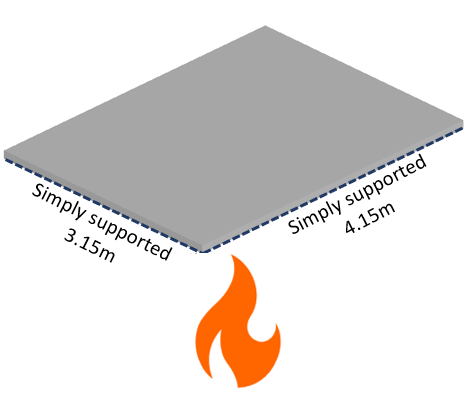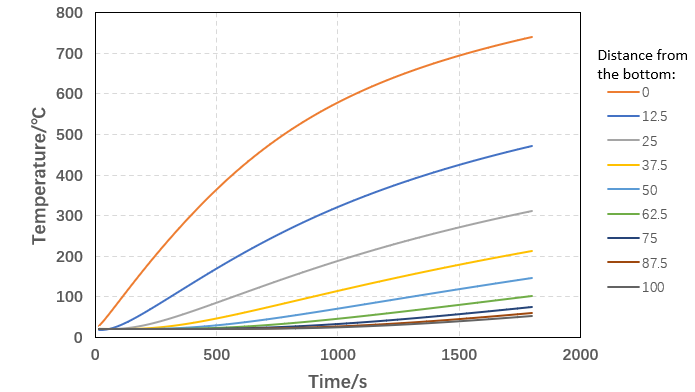Heat transfer of Concrete Slab subjected to Standard Fire
Developed by Qiujin
Introduction
Figure HT1-1 shows a 3-dimentional 4.15×3.15×0.1m concrete slab which is simply supported on the four edges. Only the bottom surface of the slab is subjected to ISO834 standard fire. HTMaterial class ConcreteEC2 is used here. Please refer to the following papers:
Jiang et al.,Thermal analysis infrastructure in OpenSees for fire and its smart application interface towards natural fire modelling, Fire Technology, 2021
Jiang et al., Modelling concrete slabs subjected to fires using nonlinear layered shell elements and concrete damage-plasticity material, Engineering Structures, 2021
| OpenSees Model | Type used for this example |
|---|---|
| HTEntity | Block(2D) or Brick(3D) |
| HTMaterial | ConcreteEC2 |
| Fire Type | Standard fire (ISO834) |
Download: This Example Package
Model Geometry
The model is to estimate the heat transfer of a flat concrete slab exposed to a furnace fire following Standard Fire curve. The slab is 100mm thick and it can be modelled either using 1D line element, 2D Block element, or 3D Brick element

Tcl scripts for model definition
2D HT model
#Definet analysis module
HeatTransfer 2D; #2D or 2d or 3D or 3d indicate the model dimension.
#Defining HeatTransfer Material
HTMaterial ConcreteEC2 1 0.0;
#Defining slab geometry: just need a cross section is enough in 2D analysis
set t 0.1;
set w 3.15;
#Defining Entity
HTEntity Block 1 0.0 [expr $t/2] $w $t; #A 2D block with its centroid at 0,t/2;
#Defining mesh:
set elemx [expr $w/20]
set elemy [expr $t/8]
HTMesh 1 1 1 -phaseChange 1 -MeshCtrls $elemx $elemy
HTMeshAll;
# define ambient temperature
SetInitialT 293.15; #Kelvin degree centigrade is used here
#Defining heat transfer boundary conditions:
HTConstants 1 4.0 293.15 0.7 0.7; # unexposed surface
HTConstants 2 25.0 293.15 0.7 0.7; # exposed surface
HTPattern AmbientBC 1 {
HeatFluxBC -HTEntity 1 -face 4 -type ConvecAndRad -HTConstants 1; #The unexposed surface
}
FireModel standard 1; #defining fire model
HTPattern fire 2 model 1 {
HeatFluxBC -HTEntity 1 -face 1 -type ConvecAndRad -HTConstants 2; #The exposed surface
}
#Defining node set that are expected to output here:
HTNodeSet 1 -Locx 0.0
HTRecorder -file tempslab2D.out -NodeSet 1
HTAnalysis HeatTransfer
HTAnalyze 120 15;
wipe;
3D HT model
#Definet analysis module
HeatTransfer 3D; #2D or 2d, or 3D or 3d indicate the model dimension.
#Defining HeatTransfer Material
HTMaterial ConcreteEC2 1 0.0;
#Defining slab geometry:
set slabw 3.15; #slab width
set slabl 4.15; #slab length
set slabt 0.1; #slab thickness
#Defining Entity:
HTEntity Brick 1 0.0 0.0 0.0 $slabw $slabt $slabl;
#A 3D brick with its centroid at 0,0,0; X-axis along its width;Y-axis is through depth and Z-axis along its length
#Defining mesh:
set elex [expr $slabw/20];
set eley [expr $slabt/8];
set elez [expr $slabl/20];
#HTMesh $MeshTag $EntityTag $MaterialTag -phaseChange -MeshCtrls $eleSizeX
HTMesh 1 1 1 -phaseChange 1 -MeshCtrls $elex $eley $elez;
HTMeshAll;
#Defining ambient temperature:
SetInitialT 293.15; #Kelvin degree centigrade is used here
#Defining heat transfer boundary conditions:
HTConstants 1 4.0 293.15 0.7 0.7; # unexposed surface
HTConstants 2 25.0 293.15 0.7 0.7; # exposed surface
HTPattern AmbientBC 1 {
HeatFluxBC -HTEntity 1 -face 2 -type ConvecAndRad -HTConstants 1; #The unexposed surface
}
FireModel standard 1; #defining fire model
HTPattern fire 2 model 1 {
HeatFluxBC -HTEntity 1 -face 1 -type ConvecAndRad -HTConstants 2; #The exposed surface
}
#Defining node set that are expected to output here:
HTNodeSet 1 -Locx 0.0 -Locz 0.0;
HTRecorder -file tempslab3D.out -NodeSet 1;
HTAnalysis HeatTransfer
#Defining analysis steps and step time;
HTAnalyze 120 15;
wipe;
Output Results
The temperature distributions of the steel beam are shown in the following figure.

Jiang, L., Jiang, Y.,Zhang, Z., Usmani, A. Thermal analysis infrastructure in OpenSees for fire and its smart application interface towards natural fire modelling, Fire Technology,2021
Jiang, L., Anwar, O., Jiang, J. & Usmani, A. (2021) Modelling concrete slabs subjected to fires using nonlinear layered shell elements and concrete damage plasticity material. Engineering Structures. doi:10.1016/j.engstruct.2021.111977.
Lim, L. & Wade, C. (2002) Experimental fire tests of two-way concrete slabs. BRANZ, New Zealand
This page is created by Liming Jiang & Zhuojun Nan, 2020